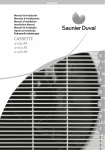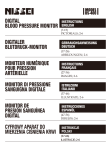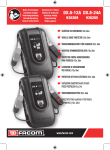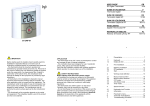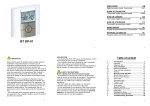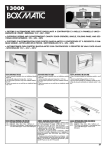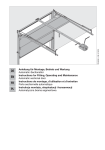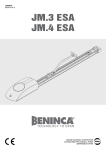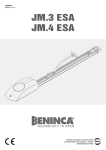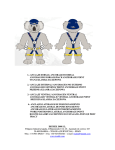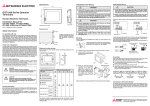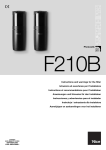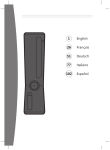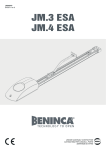Download Motore per porte garage sezionali Operator for sectional
Transcript
DS41242-001 LBT0226 Motore per porte garage sezionali Operator for sectional doors Moteur pour portes de garage en sections Motor para puertas seccionales de garaje Silnik dla bram garażowych sekcyjnych GA-MATIC PRO CF800 - 41242/800 GA-MATIC BASIC CF800 - 41242/801 GA-MATIC PRO CF1000 - 41242/810 GA-MATIC BASIC CF1000 - 41242/811 Istruzioni di installazione meccanica, uso e manutenzione Mechanical installation, use and maintenance instructions Instructions d’installation mécanique, d’utilisation et d’entretien Instrucciones de instalación mecánica, uso y mantenimiento Instrukcja instalacji, użytkowania i konserwacji DS41242-001 1 SCOPO DEL MANUALE Questo manuale è stato redatto dal costruttore ed è parte integrante del prodotto. In esso sono contenute tutte le informazioni necessarie per: • la corretta sensibilizzazione degli installatori alle problematiche della sicurezza; • la corretta installazione del dispositivo; • la conoscenza approfondita del suo funzionamento e dei suoi limiti; • il corretto uso in condizioni di sicurezza. La costante osservanza delle indicazioni fornite in questo manuale, garantisce la sicurezza dell’uomo, l’economia di esercizio e una più lunga durata di funzionamento del prodotto. Al fine di evitare manovre errate con il rischio di incidenti, è importante leggere attentamente questo manuale, rispettando scrupolosamente le informazioni fornite. Le istruzioni, i disegni, le fotografie e la documentazione contenuti nel presente manuale sono di proprietà Aprimatic S.p.A. e non possono essere riprodotti in alcun modo, né integralmente, né parzialmente. Il logo “Aprimatic” è un marchio registrato di Aprimatic S.p.A. PURPOSE OF THE MANUAL This manual was drawn up by the manufacturer and is an integral part of the product. It contains all the necessary information: • to draw the attention of the installers to safety related problems; • to install the device properly; • to understand how it works and its limits; • to use the device under safe conditions. Strict observance of the instructions in this manual guarantees safe conditions as well as efficient operation and a long life for the product. To prevent operations that may result in accidents, read this manual and strictly obey the instructions provided. Instructions, drawings, photos and literature contained herein are the exclusive property of the manufacturer and may not be reproduced by any means. The “Aprimatic” logo is a trademark registered by Aprimatic S.p.A. OBJECTIF DU MANUEL Le présent manuel a été rédigé par le fabricant et il est partie intégrante du produit. Il contient toutes les informations nécessaires pour assurer : • une bonne sensibilisation des installateurs vis-à-vis des problèmes liés à la sécurité ; • une installation correcte du dispositif ; • une connaissance approfondie de son fonctionnement et de ses limites ; • une utilisation correcte en toute sécurité. Le respect constant des recommandations ci-contenues garantira la sécurité des personnes, l’économie d’exploitation et une plus longue durée utile du produit. Afin d’éviter toute manœuvre erronée et susceptible de provoquer des accidents, il est important de lire attentivement le présent manuel et de respecter scrupuleusement les recommandations qu’il contient. Les instructions, les figures, les photographies et la documentation ci-contenues sont la propriété de la société Aprimatic S.p.A. et elles ne peuvent être reproduites en aucune manière, ni en partie ni dans leur intégralité. Le logo “Aprimatic” est une marque déposée de Aprimatic S.p.A. FINALIDAD DEL MANUAL Este manual fue redactado por el fabricante y es parte integrante del producto. El mismo contiene toda la información necesaria para: • la correcta sensibilización de los instaladores respecto de las cuestiones referidas a la seguridad; • la correcta instalación del dispositivo; • el conocimiento a fondo de su funcionamiento y de sus límites; • el correcto uso en condiciones de seguridad. El constante respeto de las indicaciones entregadas en este manual, garantiza la seguridad de las personas, la economía de funcionamiento y una mayor vida útil del producto. Para evitar maniobras erróneas con el riesgo de accidentes, es importante leer atentamente este manual, respetando al pie de la letra la información detallada. Las instrucciones, los planos, las fotografías y la documentación contenida en este manual son propiedad de Aprimatic S.p.A. y está prohibida su reproducción total o parcial mediante cualquier método. El logotipo “Aprimatic” es una marca registrada de Aprimatic S.p.A. CEL INSTRUKCJI Niniejsza instrukcja została przygotowana przez producenta i stanowi część integralną produktu. Zawiera niezbędne informacje w celu: • zwrócenia szczególnej uwagi techników instalujących na zagadnienia dotyczące bezpieczeństwa; • prawidłowego zainstalowania urządzenia; • dokładnego zapoznania się z działaniem urządzenia jak i jego ograniczeniami; • prawidłowego użytkowania w warunkach bezpieczeństwa. Stałe przestrzeganie wskazań dostarczonych w tej instrukcji, zapewni bezpieczeństwo, ekonomię pracy i wydłużenie żywotności działania produktu. W celu uniknięcia błędnych manewrów z ryzykiem wystąpienia wypadków, należy dokładnie przeczytać ten podręcznik, przestrzegając dokładnie wszystkie dostarczone instrukcje. Instrukcje, rysunki, fotografie i dokumentacja zawarta w niniejszym podręczniku są wyłączną własnością firmy Aprimatic S.p.A. i nie mogą być powielane w jakikolwiek sposób. Logo „Aprimatic” jest znakiem towarowym zarejestrowanym przez Aprimatic S.p.A. 2 DS41242-001 DICHIARAZIONE DI CONFORMITÀ ALLA DIRETTIVA 1999/5/CE Con la presente Aprimatic dichiara che il motore GA-Matic è conforme ai requisiti essenziali ed alle altre disposizioni pertinenti stabilite dalla direttiva 1999/05/CE. La dichiarazione di conformità CE è disponibile presso il servizio clienti Aprimatic oppure può essere consultata attraverso il sito internet www.aprimatic.com. DECLARATION OF CONFORMITY TO DIRECTIVE 1999/5/EC Aprimatic hereby declares that the GA-Matic operator complies with the essential requirements and other relevant provisions of Directive 1999/5/EC. The Declaration of Conformity can be downloaded from the website at www.aprimatic.com or requested from Aprimatic Customer Service. DÉCLARATION DE CONFORMITE À LA DIRECTIVE 1999/5/CE Par la présente, la société Aprimatic déclare que le moteur GA-Matic est conforme aux exigences essentielles et aux autres dispositions applicables, établies par la Directive 1999/05/CE. La déclaration de conformité CE est disponible auprès du Service Clients Aprimatic ou sur le site Internet www.aprimatic.com. DECLARACION DE CONFORMIDAD DE LA DIRECTIVA 1999/5/EC Con la presente, Aprimatic declara que el motor GA-Matic responde a los requisitos básicos y a las otras reglamentaciones pertinentes, establecidas por la directiva 1999/05/CE. La declaración de conformidad CE está disponible en el servicio de atención al cliente de Aprimatic o se puede consultar en el sitio internet www.aprimatic.com. ZGODNOŚĆ Z DYREKTYWĄ R&TTE 99/05/CE Niniejszym Aprimatic oświadcza, że silnik GA-Matic jest zgodny z zasadniczymi wymogami oraz z innymi postanowieniami ustalonymi przez Dyrektywę 1999/05 / CE. Deklaracja zgodności CE jest dostępna w biurze obsługi klienta Aprimatic lub można zapoznać się z nią na stronie internetowej www.aprimatic.com. DS41242-001 3 ITALIANO SOMMARIO 1 2 3 4 5 6 7 8 9 10 11 12 13 DESCRIZIONE DEL KIT .....................................................................................................................................5 1.1 KIT GA-MATIC PRO ...............................................................................................................................5 1.2 KIT GA-MATIC BASIC ............................................................................................................................5 FUNZIONI BASE .................................................................................................................................................5 FUNZIONI SPECIALI ..........................................................................................................................................5 INSTALLAZIONE .................................................................................................................................................6 4.1 Installazione (guida di acciaio) ................................................................................................................7 4.2 Installazione (guida di acciaio sezionale)................................................................................................8 CONSIGLI PER L’INSTALLAZIONE .................................................................................................................10 IMPOSTAZIONE E UTILIZZAZIONE DELLE FUNZIONI BASE .......................................................................11 6.1 Impostazione del finecorsa - Autoapprendimento della forza di apertura e chiusura ...........................11 6.2 Abbinamento di ricevitore e trasmettitore .............................................................................................11 6.3 Regolazione della sensibilità antischiacciamento .................................................................................12 6.4 Impostazione della chiusura automatica ...............................................................................................12 6.5 Impostazione della fotocellula ...............................................................................................................12 6.6 Morsetto Start........................................................................................................................................12 UTILIZZAZIONE DELLE FUNZIONI SPECIALI ................................................................................................12 SGANCIO MANUALE........................................................................................................................................13 MANUTENZIONE ..............................................................................................................................................14 NOTE FINALI ....................................................................................................................................................14 INFORMAZIONI IMPORTANTI PER L’UTILIZZATORE ...................................................................................14 CONTENUTO DELLA CONFEZIONE ...............................................................................................................14 DATI TECNICI ...................................................................................................................................................15 4 DS41242-001 1 1.1 DESCRIZIONE DEL KIT KIT GA-MATIC PRO KIT PRO CF 800 - cod. 41242/800 KIT PRO CF 1000 - cod. 41242/810 Il kit contiene: 9 Motore per porte garage sezionali 9 Guida 3m con cinghia di trasmissione 9 2 Radiocomandi 9 Cartello di segnalazione Aprimatic 1.2 KIT GA-MATIC BASIC KIT BASIC CF 800 - cod. 41242/801 KIT BASIC CF 1000 - cod. 41242/811 Il kit contiene: 9 Motore per porte garage sezionali 9 Guida 3m con cinghia di trasmissione 9 Cartello di segnalazione Aprimatic 2 FUNZIONI BASE • Avvio graduale, arresto graduale. Minimizzazione del carico iniziale su motore per porta garage e porta garage • Autoapprendimento della forza di apertura e chiusura • Rilevamento della forza di sovraccarico: la porta torna automaticamente indietro di oltre 15 cm in caso di sovraccarico durante la chiusura e si arresta in caso di sovraccarico durante l’apertura. • Protezione per bassa tensione: non viene eseguita alcuna azione di apertura o chiusura se la tensione è troppo bassa, in modo da non danneggiare l’anta mobile e l’unità di controllo. • Utilizzo del trasmettitore rolling code, con miliardi di codici non coincidenti e che non possono essere piratati. • Funzione di chiusura automatica • Telaio in metallo • Interfaccia per batteria tampone in caso di assenza di alimentazione. • Interfaccia per interruttore a parete. • Interfaccia per fotocellula: la porta torna ad aprirsi se, durante la chiusura, viene rilevato un ostacolo. • Pulsante B di avvio/arresto chiusura (per rendere più semplice la regolazione, la manutenzione e l’apertura o chiusura di emergenza) 3 FUNZIONI SPECIALI Le seguenti funzioni vengono implementate su ordinazione in base a speciali esigenze dei clienti: 1. Spia di avvertenza (opzionale) 2. Protezione per porta pedonale (opzionale) DS41242-001 5 4 INSTALLAZIONE LEGGERE ATTENTAMENTE LE ISTRUZIONI • Verificare che la struttura della porta sia robusta e idonea ad essere azionata dal motore. • Verificare che, durante il movimento della porta, non vi sia alcun punto di attrito. • La porta deve essere correttamente bilanciata e deve essere possibile abbassarla e sollevarla facilmente a mano. 6 2 1 3 7 5 4 4 FIG. 1 Fare riferimento alla Fig. 1 per l’installazione consigliata. 1) Guida 2) Lampeggiatore 24 Vcc (opzionale) 3) Interruttore a parete (opzionale) 4) Fotocellula (opzionale) 5) Tastiera di programmazione 6) Presa di alimentazione 7) Motore per porta del garage In fase di installazione prevedere uno spazio di almeno 30 mm tra la guida di scorrimento del motore e la massima altezza che può raggiungere l’anta quando è completamente aperta (Fig. 2). Verificare che la guida sia perfettamente perpendicolare all’albero. Accertarsi che la connessione della staffa di sospensione F al soffitto sia sufficientemente stabile (Fig. 3). 30 mm FIG. 2 FIG. 3 Attenzione: Assicurarsi di fissare il motore per porta garage alla muratura del soffitto e non al cartongesso. Un fissaggio non saldo e sicuro potrebbe portare alla caduta del motore con possibili gravi danni a persone e/o cose. 6 DS41242-001 4.1 INSTALLAZIONE (GUIDA DI ACCIAIO) Braccio diritto Perno assiale Staffa a muro Staffa a U Staffa della porta Braccio curvo Staffa di sospensione FIG. 4 1. Fissare al muro la staffa per la guida 2 - 15 cm sopra l’albero o la staffa intermedia (a seconda dell’effettivo spazio di installazione). 2. Fissare la guida di acciaio alla staffa a muro con il perno assiale. (Fig. 4) 3. Fissare il motore per porta garage alla guida per mezzo della staffa a U. È sufficiente una forza di fissaggio di 2 Nm. 4. Fissare il motore al soffitto per mezzo della staffa di sospensione. Avvertenza: Verificare che la guida sia perfettamente perpendicolare all’albero. Accertarsi che la connessione della staffa di sospensione al soffitto sia sufficientemente stabile. 5. Fissare il cavo della frizione. 6. Rilasciare la frizione e provare ad aprire e chiudere a mano la porta. Verificare che non vi sia resistenza tra l’anta mobile e la guida. 7. Collegare il motore per porta garage all’alimentazione e regolarne il funzionamento. Avvertenza: Verificare che la tensione di alimentazione del motore sia uguale a quella del luogo. Collegare il motore ad una alimentazione dotata di protezione di terra. DS41242-001 7 4.2 INSTALLAZIONE (GUIDA DI ACCIAIO SEZIONALE) • Come illustrato nella Fig. 5, fare scorrere la rotaia terminale e la rotaia centrale nel primo raccordo. • Come illustrato nella Fig. 6, fare scorrere il secondo raccordo sull’altra estremità della rotaia centrale e fare scorrere la rotaia superiore nel secondo raccordo. • Rimuovere la pellicola plastificata dalla rotaia terminale e tagliare la fascetta stringicavo di plastica sull’asta filettata “A”. • Come illustrato nella Fig. 7, tirare l’asta filettata “A” insieme alla catena interna fino all’estremità della rotaia superiore. • Come illustrato nella Fig. 8, rimuovere il dado e la molla. • Serrare il dado nella posizione corretta come illustrato nella Fig. 9, tagliare la fascetta stringicavo di plastica sulla ruota dentata e terminare il montaggio dell’intera rotaia. Rotaia centrale Rotaia terminale Primo raccordo FIG. 5 Rotaia superiore Rotaia centrale Rotaia terminale Secondo raccordo Primo raccordo FIG. 6 8 DS41242-001 FIG. 7 FIG. 8 19 mm FIG. 9 DS41242-001 9 5 CONSIGLI PER L’INSTALLAZIONE Tenere presente che esistono specifiche norme da rispettare rigorosamente che riguardano la sicurezza degli impianti elettrici e l’installazione di porte e cancelli automatici. Per quanto riguarda i requisiti di legge e le norme da rispettare, prestare attenzione ai punti seguenti per garantire la massima sicurezza e affidabilità dell’installazione. 1. Prima dell’installazione, controllare l’ambiente circostante. Valutare attentamente qualsiasi pericolo che potrebbe causare danni fisici (veicoli in transito, parti di alberi in caduta ecc.), possibili contatti con i corpi delle persone (insetti, foglie ecc.), pericoli di allagamenti o qualsiasi altro evento eccezionale. 2. Verificare che il valore della tensione di rete sia uguale a quello riportato sulla targhetta e in questo manuale. 3. Accertarsi che l’alimentazione di rete disponga di una idonea protezione contro cortocircuiti/sovratensioni e di una corretta protezione di terra. Tenere sempre a mente che all’interno dell’unità è presente la tensione di rete (pericolo di scosse elettriche e di incendio). 4. Prestare attenzione all’unità di controllo: i suoi componenti possono danneggiarsi se l’unità viene utilizzata in modo eccessivo. 5. Accertarsi di disporre di tutto il materiale necessario e che esso sia idoneo per l’uso che se ne intende fare. 6. Leggere attentamente tutte le istruzioni e assicurarsi che siano ben comprese prima di procedere all’installazione del motore per porta garage. 7. Prima di procedere all’installazione, analizzare attentamente tutti i rischi relativi all’automazione della porta. Verificare che la porta venga automatizzata in modo affidabile e che i meccanismi siano in buono stato di funzionamento. Rispettare i margini di sicurezza e le distanze minime. 8. Valutare con attenzione i dispositivi di sicurezza da installare e il corretto posto dove installarli; se necessario, installare sempre un dispositivo di arresto di emergenza per interrompere l’alimentazione del motore per porta garage. 9. Una volta analizzati i rischi, installare il motore per porta garage e i relativi dispositivi di sicurezza, l’arresto di emergenza e/o le cellule fotoelettriche. Nota bene: come ulteriore norma di sicurezza, si consiglia vivamente di montare delle cellule fotoelettriche di sicurezza in tutte le installazioni. 10. Quando si installa il motore per porta garage, attenersi rigorosamente alle istruzioni riportate nel manuale di istruzioni. Se alcuni punti o alcune procedure di questo manuale risultassero poco chiari, non procedere all’installazione prima di aver chiarito tutti i dubbi con il nostro ufficio tecnico. 10 DS41242-001 6 6.1 IMPOSTAZIONE E UTILIZZAZIONE DELLE FUNZIONI BASE IMPOSTAZIONE DEL FINECORSA - AUTOAPPRENDIMENTO DELLA FORZA DI APERTURA E CHIUSURA Premere e tenere premuto il pulsante SET finché il display non visualizzi 1; quindi regolare il limite superiore premendo il pulsante UP. Regolare in modo fine la posizione del limite superiore finale con i pulsanti UP o DOWN e poi premere il pulsante SET. Il display visualizza automaticamente 2. Regolare il limite inferiore premendo il pulsante DOWN. Regolare in modo fine la posizione del limite inferiore finale con i pulsanti UP o DOWN e poi premere il pulsante SET. Il motore per porta garage eseguirà automaticamente un ciclo per memorizzare le posizioni limite e la forza di apertura e chiusura. 6.2 ABBINAMENTO DI RICEVITORE E TRASMETTITORE Premere e tenere premuto il pulsante CODE finché nel display non si illumini il punto (Fig. A). Quindi, premere una volta un qualsiasi pulsante sul trasmettitore: il punto si spegne; premendo di nuovo il pulsante, il punto lampeggia velocemente e poi il display visualizza quanto illustrato nella Fig. B. A questo punto, il trasmettitore è disponibile. Premere il pulsante CODE per più di 8 secondi finché il display non visualizzi “C”: tutti i codici memorizzati vengono cancellati. Fig. A Fig. B DS41242-001 11 6.3 REGOLAZIONE DELLA SENSIBILITÀ ANTISCHIACCIAMENTO Premere e tenere premuto il pulsante SET finché il display non visualizzi 3. Questa è la modalità di regolazione della forza. Premere il pulsante UP per aumentare la forza e il pulsante DOWN per ridurla. I valori massimo e minimo della forza sono 9 e 1, rispettivamente. Premere il tasto SET per confermare. 6.4 IMPOSTAZIONE DELLA CHIUSURA AUTOMATICA Premere e tenere premuto il pulsante UP finché il display non visualizzi ‘-’. Premere una volta il pulsante UP: il tempo di chiusura automatica viene incrementato di 1 minuto; il tempo massimo è di 9 minuti. Premendo il pulsante DOWN, il tempo di chiusura automatica viene decrementato di 1 minuto. La funzione di chiusura automatica è disabilitata se il display visualizza 0. Premere il tasto SET per confermare. 6.5 IMPOSTAZIONE DELLA FOTOCELLULA Premere e tenere premuto il pulsante DOWN finché il display non visualizzi 11. Premendo il pulsante UP, il display visualizza H: la funzione della fotocellula è disponibile. Per annullare questa funzione, premere il pulsante DOWN: il display visualizza 11. Al termine dell’impostazione, premere il pulsante SET per confermare. Avvertenza: disabilitare la funzione della fotocellula se non si utilizza un sensore fotoelettrico. 6.6 MORSETTO START Collegando un interruttore a questo morsetto, è possibile utilizzare tale interruttore durante la manutenzione o quando si lascia il trasmettitore nel garage. 7 UTILIZZAZIONE DELLE FUNZIONI SPECIALI 1. L’interfaccia START è disponibile Aggiungere un altro pulsante START per aprire o chiudere la porta. 2. Lampeggiatore Collegare il lampeggiatore a un’alimentazione 24 Vcc, corrente ≤ 100 mA. 3. Protezione per porta pedonale (opzionale) Questa funzione impedisce l’apertura della porta se la porta pedonale non è chiusa. In questo modo, l’anta mobile non si danneggia. Eseguire i collegamenti riportati nella Fig. 10. 12 DS41242-001 COLLEGAMENTO DEL CONTROLLO PER FOTOCELLULA/INTERRUTTORE FIG. 10 8 SGANCIO MANUALE Il motore per porta garage è dotato di un cavo di sblocco manuale per sganciare il carrello e poter muovere a mano la porta tenendo abbassata la maniglia (Fig.11). Tirare la maniglia per sganciare il carrello. Per riagganciare la porta, attivare il motore per porta garage in modalità automatica o muovere a mano la porta finché l’attacco non si agganci al carrello. Nei casi in cui non è presente una porta pedonale, si consiglia di installare un dispositivo di sgancio esterno (Fig.12). FIG. 11 DS41242-001 FIG. 12 13 9 MANUTENZIONE Per la scheda dei circuiti logici non è richiesta alcuna particolare manutenzione. - Controllare almeno due volte l’anno che la porta sia correttamente bilanciata e che tutte le parti attive siano in buone condizioni di funzionamento. - Controllare almeno due volte l’anno la sensibilità di inversione e regolarla se necessario. Verificare che i dispositivi di sicurezza (fotocellule ecc.) funzionino correttamente. Avvertenza: un non corretto funzionamento della porta può influenzare la durata del motore per porta garage automatico a causa dei carichi non corretti e invalidare la garanzia. 10 NOTE FINALI Il presente manuale è esclusivamente destinato a tecnici qualificati per eseguire l’installazione. Le informazioni non riportate nel presente manuale non sono considerate di alcun interesse per l’utilizzatore finale. È importante che l’installatore mostri ai propri clienti il corretto funzionamento del motore per porta garage, compreso l’utilizzo del cavo di sgancio manuale. Informare il proprietario della necessità di una regolare e accurata manutenzione, in particolare del controllo dei dispositivi di sicurezza e di inversione. 11 INFORMAZIONI IMPORTANTI PER L’UTILIZZATORE Una volta installato il motore per porta garage, l’utilizzatore deve essere informato sul suo modo di funzionare e su tutti i rischi derivanti dal suo uso non corretto. L’utilizzatore deve evitare di porsi in situazioni pericolose come sostare all’interno del raggio di funzionamento della porta durante il suo movimento. Non lasciare che i bambini giochino nelle vicinanze della porta e tenere i telecomandi lontani dalla loro portata. Tutti gli interventi di assistenza, riparazione e controllo devono essere eseguiti da professionisti qualificati e annotati in un registro di manutenzione conservato dall’utilizzatore. NOTA IMPORTANTE: In caso di un malfunzionamento, l’utilizzatore deve rivolgersi ad un installatore autorizzato e non tentare di riparare l’unità. 12 14 CONTENUTO DELLA CONFEZIONE 9 Motore per porta garage: 1 9 Cinghia da 3 metri in dotazione: 1 9 Staffe di fissaggio del motore: 2 9 Staffa per la rotaia: 1 9 Staffa della porta: 1 9 Maniglia: 1 9 Confezione di viti e bulloni 1 9 Staffe di sospensione: 2 9 Collegamento braccio porta: 2 9 Telecomando: 2 (solo per GA-MATIC PRO CF800 e GA-MATIC PRO CF1000) 9 Manuale di istruzioni: 1 DS41242-001 13 DATI TECNICI Modello Alimentazione ingresso Tensione in uscita Potenza massima Velocità di apertura/chiusura Lampada Tempo di illuminazione Decodifica TLC Frequenza radio CF 800 220-240Vca 50/60Hz 235W 800N 0.15 m/s LED, 24Vcc 3 minuti Rolling code 2 batterie 12 V 3,5 A 433.92MHz CF 1000 220-240Vca 50/60Hz 245W 1000N 0.15 m/s LED, 24Vcc 3 minuti Rolling code 2 batterie 12 V 3,5 A 433.92MHz Temperatura di funzionamento -20°C ÷ +40°C -20°C ÷ +40°C Umidità relativa Dimensioni massima porta Motore Radiocomandi configurabili Dimensioni (mm) ‹ 90% 12 m2 24Vcc Fino a 20 400x250x150 ‹ 90% 14 m2 24Vcc Fino a 20 400x250x150 DS41242-001 15 ENGLISH CONTENTS 1 2 3 4 5 6 7 8 9 10 11 12 13 KIT DESCRIPTION ...........................................................................................................................................17 1.1 GA-MATIC kit PRO ...............................................................................................................................17 1.2 GA-MATIC kit BASIC ............................................................................................................................17 BASIC FUNCTION INTRODUCTION ...............................................................................................................17 SPECIAL FUNCTION INTRODUCTION ...........................................................................................................17 INSTALLATION .................................................................................................................................................18 4.1 Installation (steel guide) ........................................................................................................................19 4.2 Installation (sectional steel guide) .........................................................................................................20 INSTALLATION RECOMMENDATIONS ..........................................................................................................22 BASIC FUNCTION SETTING AND APPLYING ................................................................................................23 6.1 Travel Limit setting - Opening and closing force self-learning ..............................................................23 6.2 Matching the receiver and transmitter...................................................................................................23 6.3 Safety reverse force adjustment ...........................................................................................................24 6.4 Auto-close setting..................................................................................................................................24 6.5 Photo beam setting ...............................................................................................................................24 6.6 Start Terminal........................................................................................................................................24 SPECIAL FUNCTION INTRODUCTION AND APPLICATION .........................................................................24 MANUAL DISENGAGEMENT ...........................................................................................................................25 MAINTENANCE ................................................................................................................................................26 FINAL NOTES ...................................................................................................................................................26 IMPORTANT INFORMATION FOR THE USER ...............................................................................................26 PACKING LIST ..................................................................................................................................................26 TECHNICAL SPECIFICATIONS .......................................................................................................................27 DS41242-001 16 1 1.1 KIT DESCRIPTION GA-MATIC KIT PRO CF 800 PRO KIT - ref. 41242/800 CF 1000 PRO KIT - ref. 41242/810 The kit contains: 9 Operator for sectional door 9 1 x 3 mt guide with transmission belt 9 2 x remote control 9 Aprimatic signal plate 1.2 GA-MATIC KIT BASIC CF 800 BASIC KIT - ref. 41242/801 CF 1000 BASIC KIT - ref. 41242/811 The kit contains: 9 Operator for sectional door 9 1 x 3 mt guide with transmission belt 9 Aprimatic signal plate 2 • • • • • • • • • • • 3 BASIC FUNCTION INTRODUCTION Soft start, soft stop. Minimize start-up load on garage door opener and garage door Opening and closing force self-learning Overloading force detecting: the door will reverse more than 15 cm automatically when it is overloaded when losing and will stop when it is overloaded when opening. Low-voltage protection: the process will not perform any action of opening and closing when voltage is too low, door panel and controller won’t be damaged. We adopt rolling code transmitter, with billions of codes, won’t be coincident code or pirated code. With auto-closing feature. Metal chassis Backup battery interface available, in case of power failure. Wall switch interface available. Photo beam interface available, the door will change to open when obstruction is detected while closing. Start/Stop close button B (make adjustment, maintenance and emergent opening or closing easier) SPECIAL FUNCTION INTRODUCTION The following functions are made to order in accordance with the special needs of customers: 1. Caution light feature (optional) 2. Pass door protection feature (optional) DS41242-001 17 4 INSTALLATION READ THE INSTRUCTION CAREFULLY • Make sure the door structure is solid and suitable to be motor driven. • Make sure when the door is moving there are no friction point. • The door must be properly balanced and must be easily lowered and raised by hand. 6 2 1 3 7 5 4 4 FIG.1 Referring to Fig. 1 for recommended installation. 1) Guide 2) 24VDC flash light (optional) 3) Wall switch (optional) 4) Photo beam (optional) 5) Programming panel 6) Power socket 7) Door opener Maintaining a minimum gap of 30mm from the top panel’s maximum height (Fig. 2). Make sure the guide is horizontal and vertical to the shaft. Make sure the connection of hanging bracket F and ceiling is firm enough (Fig. 3). 30mm FIG.2 FIG.3 Warning: Make sure the opener is affixed to noggins in ceiling and not to plasterboard. Failure to have a safe and secure fixing will lead to opener falling, and cause serious persons and /or property damage. 18 DS41242-001 4.1 INSTALLATION (STEEL GUIDE) FIG.4 1. Fixing the track bracket to the wall 2cm-15cm over the shaft or intermediate bracket (depending on the actual installation space). 2. Fixing the steel track to the wall bracket with axis pin. (Fig. 4) 3. Fixing garage door opener to the track by U bracket. It’s enough for 2 Nm fastening force. 4. Fixing the opener on ceiling by hanging bracket. Notice: Make sure the guide is horizontal and vertical to the shaft. Make sure the connection of hanging bracket and ceiling is firm enough. 5. Fix the clutch cord. 6. Release the clutch, try to open and close the door by hand. Make sure there is no resistance between door panel and track. 7. Connecting the opener with power and adjusting the operation. Notice: Make sure the opener’s voltage is in accordance with the local voltage. Connect the opener to a properly earthed power supply. DS41242-001 19 4.2 INSTALLATION (SECTIONAL STEEL GUIDE) • As FIG.5, slide the end rail into the 1st sleeve, slide the middle rail into the 1st sleeve; • As FIG.6, slide the 2nd sleeve to the other end of middle rail, slide the top rail into the 2nd sleeve; • Remove the plastic film on the end rail, cut the plastic cable tie on the screw rod ”A”; • As FIG.7, pull the screw rod ”A” along with inner chain to the end of top rail ; • As FIG.8, undo the nut and spring; • Tight the nut to the right position as shown in Fig.9, cut the plastic cable tie on sprocket, then whole rail assembled finished. The middle rail The end rail The first sleeve FIG.5 The top rail The middle rail The end rail The second sleeve The first sleeve FIG.6 20 DS41242-001 FIG.7 FIG.8 19 mm FIG.9 DS41242-001 21 5 INSTALLATION RECOMMENDATIONS Remember there are specific standards that have to be strictly followed regarding the safety rules of electrical installations and automatic gates and doors. As for the legal requirements and standards that must be adhered to, please take notice of the following points to ensure maximum safety and reliability of your installation: 1. Before installing, check the surrounding environment. Carefully evaluate any hazards which could be physical damage (transiting vehicles, parts of trees falling etc.), possible contact with persons’ bodies (insects, leaves, etc.), flooding hazards, or any other exceptional events. 2. Check the main voltage numbers is the same as the numbers that are given on the rating plate and in this manual. 3. Check and make sure if there is suitable electrical protection against short circuits/power spikes and proper earthed on the main supply. Remember the unit having main voltage running through it (electrocution hazard, fire hazard). 4. Take care with the control unit; the parts may be subject to damage if the control unit is abused. 5. Make sure that you have all the necessary materials, and they are suitable for this kind of use. 6. Read all the instructions thoroughly and make sure they are understood before attempting to install the opener. 7. Before starting the installation carefully analyze all the risks relating to automating the door. Verify that the door is automated in a sound condition and that the mechanisms are in good working order. Observe the safety margins and minimum distances. 8. Carefully evaluate the safety devices to be installed and the right place to install them; always install an emergency stop device for power interruption to the opener if it is required. 9. Once the risks have been analyzed, install the opener and relative safety devices, emergency stop and/or photoelectric cells. Important note: as for additional safety rules, we strongly recommends the fitting of Photo Electric safety beams on all installations. 10. While installing the opener, strictly follow all the instructions given in the instruction manual. If some points or procedures in this manual are not very clear, do not install the unit until all doubts have been cleared up with our technical department. 22 DS41242-001 6 6.1 BASIC FUNCTION SETTING AND APPLYING TRAVEL LIMIT SETTING - OPENING AND CLOSING FORCE SELF-LEARNING Press SET button and hold on until the LED displays 1, then adjust the up limit by pressing UP button. Fine-tuning UP or DOWN button to determine the final up limit position then press SET button. The display turns into 2 automatically. Adjust the down limit by pressing DOWN button. Fine-tuning UP or DOWN button to determine the final down limit position then press SET button. The opener will operate a cycle automatically to remember the limit positions and the opening and closing force. 6.2 MATCHING THE RECEIVER AND TRANSMITTER Press CODE button and hold on until the LED dot is on (Fig. A). Then press any button on the transmitter once, the dot will be off; pressing the button again the dot will fast flash then LED displays Fig. B. After that the transmitter will be available. Press CODE button more than 8 seconds until the LED displays C, all the stored codes will be deleted. Fig. A Fig. B DS41242-001 23 6.3 SAFETY REVERSE FORCE ADJUSTMENT Press SET button and hold on until the LED displays 3. It’s under force adjustment mode. Press UP button to increase the force and DOWN button to decrease the force. The maximum force is 9 and the minimum is 1. Press SET button to confirm. 6.4 AUTO-CLOSE SETTING Press UP button and hold on until the LED displays ‘-’. Press UP button once, the auto-close time will increase 1 minute, the maximum time is 9 minutes. Press DOWN button the auto-close time decrease 1 minute. The auto-close function will be turned off when LED displays 0. Press SET button to confirm. 6.5 PHOTO BEAM SETTING Press DOWN button and hold on until the LED displays 11. Pressing UP button, the LED displays H, photo beam function is available. To cancel this function press DOWN button, the LED displays 11. When setting is finished, press SET to confirm. Notice: Close the photo beam function when you don’t use photo beam sensor. 6.6 START TERMINAL Connecting a touch off switch to this terminal, you can use the switch when maintaining or the transmitter is left in garage. 7 SPECIAL FUNCTION INTRODUCTION AND APPLICATION 1. The START interface available Add another START button to open or close the door. 2. Flash light function Connect the flash light with DC 24V, current ≤ 100mA. 3. Pass door protection (optional) This function ensure that the door can’t be opened unless the small pass door is closed. The door panel won’t be damaged. Connect according to Fig.10. 24 DS41242-001 CONNECTION OF PHOTO BEAM/SWITCH CONTROL FIG. 10 8 MANUAL DISENGAGEMENT The opener is equipped with a manual release cord to disengage shuttle and move door by hand while holding the handle down (Fig.11). Pull on the handle to disengage the shuttle. To re-engage the door simply run opener in automatic mode or move door by hand until the trolley engages in the chain shuttle. In some situations that a pedestrian door is not in state, it is recommended that an external disengagement device should be fitted (Fig.12). FIG. 11 DS41242-001 FIG. 12 25 9 MAINTENANCE No particular maintenance is required for the logic circuit board: - Check the door at least twice a year if it is properly balanced and all working parts are in good working condition or not. - Check the reversing sensitivity at least twice a year, and adjust if it is necessary. Make sure that the safety devices are working effectively (photo beams, etc.) Notice: a rude operating door can affect the life of the automatic opener due to incorrect loads and will void the warranty. 10 FINAL NOTES This manual is only used by technical persons who are qualified to carry out the installation. No given information in this manual can be considered of any interest to the end user. It is important for the installer to show their clients correct operation using of the opener including the using of manual disengagement cord. Inform the owner about the need of a regular and accurate maintenance, especially regarding a regular check of the safety and reversing devices. 11 IMPORTANT INFORMATION FOR THE USER Once the opener has been installed, the user must be informed about how it works and all the risks that can arise if it is used improperly. The user must avoid placing himself/herself in dangerous situations such as standing within the door’s operating range when it is moving. Do not let children play near the door, and keep the remote controls out of their reach. All services, repairs or checks must be carried out by professionally qualified persons, and noted on a maintenance register kept by the user. IMPORTANT NOTE: In the case of a malfunction the user must call an authorized installer and should not attempt to repair it by yourself. 12 26 PACKING LIST 9 Door head operator: 1 9 3 meters rail belt equiped: 1 9 Head operator fixing brackets: 2 9 Rail bracket: 1 9 Door bracket: 1 9 Handle: 1 9 Screw and bolt package: 1 9 Brackets for suspend application: 2 9 Door arm connection: 2 9 Remote control: 2 (for GA-MATIC PRO CF800 and GA-MATIC PRO CF1000 only) 9 Instruction manual: 1 DS41242-001 13 TECHNICAL SPECIFICATIONS Model Power Input Output power Max force Open/Close speed Lamp Light time Decoding Transmitter power Radio frequency Working temperature Relative humidity Max door area Engine Programmable Remote control Dimensions CF 800 200-240VAC - 50/60Hz 235W 800N 0.15m/s LED 24VDC 3 minutes Rolling code 23A 12V battery 433.92MHz or other on request -20° ÷ 40° < 90% 12 m2 24VDC Up to 20 400 x 250 x 150mm CF 1000 200-240VAC - 50/60Hz 245W 1000N 0.15m/s LED 24VDC or bulb 220VAC 3 minutes Rolling code 23A 12V battery 433.92MHz or other on request -20° ÷ 40° < 90% 14 m2 24VDC Up to 20 400 x 250 x 150mm DIMENSIONS mm Width Height Depth Max stroke DS41242-001 27 FRANÇAIS TABLE DES MATIERES 1 2 3 4 5 6 7 8 9 10 11 12 13 28 DESCRIPTION DU KIT .....................................................................................................................................29 1.1 KIT GA-MATIC PRO .............................................................................................................................29 1.2 KIT GA-MATIC BASIC ..........................................................................................................................29 FONCTIONS DE BASE .....................................................................................................................................29 FONCTIONS SPÉCIALES ................................................................................................................................29 INSTALLATION .................................................................................................................................................30 4.1 Installation (rail en acier) .......................................................................................................................31 4.2 Installation (rail en acier en sections)....................................................................................................32 CONSIGNES D'INSTALLATION .......................................................................................................................34 CONFIGURATION ET UTILISATION DES FONCTIONS DE BASE ................................................................35 6.1 Configuration du fin de course – auto-apprentissage de la force d’ouverture/fermeture .....................35 6.2 Association du recepteur et de l’emetteur.............................................................................................35 6.3 Réglage de la sensibilité anti-ecrasement ............................................................................................36 6.4 Configuration de la fermeture automatique ..........................................................................................36 6.5 Configuration de la photocellule............................................................................................................36 6.6 Borne “Start”..........................................................................................................................................36 UTILISATION DES FONCTIONS SPÉCIALES.................................................................................................36 DECROCHAGE MANUEL .................................................................................................................................37 ENTRETIEN ......................................................................................................................................................38 PRECONISATIONS FINALES ..........................................................................................................................38 INFORMATIONS IMPORTANTES POUR L’UTILISATEUR .............................................................................38 CONTENU DE L’EMBALLAGE .........................................................................................................................38 CARACTERISTIQUES TECHNIQUES .............................................................................................................39 DS41242-001 1 1.1 DESCRIPTION DU KIT KIT GA-MATIC PRO KIT PRO CF 800 - code 41242/800 KIT PRO CF 1000 - code 41242/810 Le kit contient : 9 Moteur pour portes de garage en sections 9 Rail 3m avec courroie de transmission 9 2 radiocommandes 9 Pancarte de signalisation Aprimatic 1.2 KIT GA-MATIC BASIC KIT BASIC CF 800 - code 41242/801 KIT BASIC CF 1000 - code 41242/811 Le kit contient : 9 Moteur pour portes de garage en sections 9 Rail 3m avec courroie de transmission 9 Pancarte de signalisation Aprimatic 2 FONCTIONS DE BASE • Démarrage et arrêt progressifs. Minimisation de la charge initiale sur le moteur et la porte de garage. • Auto-apprentissage de la force d’ouverture/fermeture • Détection de la force de surcharge : la porte recule automatiquement de plus de 15 cm en cas de surcharge pendant sa fermeture et elle s’arrête en cas de surcharge pendant son ouverture. • Protection pour basse tension : aucune opération d’ouverture/fermeture n’est exécutée si la tension est insuffisante, de manière à ne pas endommager le battant mobile et l’unité de commande. • Utilisation d’un émetteur du type rolling code, avec des milliards de codes univoques, qui ne peuvent pas être piratés. • Fonction fermeture automatique. • Châssis métallique. • Interface pour batterie tampon en l’absence d’alimentation. • Interface pour interrupteur mural. • Interface pour photocellule : la porte s’ouvre de nouveau si un obstacle est détecté pendant sa fermeture. • Bouton B de démarrage/arrêt fermeture (pour faciliter le réglage, l’entretien et l’ouverture/fermeture d’urgence). 3 FONCTIONS SPÉCIALES Les fonctions suivantes sont disponibles en option, selon les exigences spécifiques des clients : 1. Témoin d’avertissement (en option) 2. Protection pour porte piétonne (en option) DS41242-001 29 4 INSTALLATION LIRE ATTENTIVEMENT LES INSTRUCTIONS • Vérifier que la structure de la porte est solide et apte à être commandée par le moteur. • Vérifier l’absence de points de frottement pendant le mouvement de la porte. • La porte doit être correctement équilibrée et il doit être possible de la baisser/soulever sans effort manuellement. 6 2 1 3 7 5 4 4 FIG. 1 Se reporter à la Fig. 1 pour l’installation conseillée. 1) Rail 2) Témoin clignotant 24 Vcc (en option) 3) Interrupteur mural (en option) 4) Photocellule (en option) 5) Clavier de programmation 6) Prise d’alimentation 7) Moteur pour porte de garage Lors de l’installation, prévoir un espace d’au moins 30 mm entre le rail de coulissement du moteur et la hauteur maximale atteinte par le battant lorsqu’il est complètement ouvert (Fig. 2). Vérifier que le rail est parfaitement perpendiculaire à l’arbre. S’assurer que la fixation de l’étrier de suspension F au plafond est suffisamment stable (Fig. 3). 30 mm FIG. 2 FIG. 3 Attention : S’assurer de fixer le moteur pour porte de garage à la maçonnerie du plafond, pas à une surface en plaque de plâtre. Une fixation peu solide et non sécurisée pourrait entraîner la chute du moteur, d’où de possibles graves dommages corporels et/ou matériels. 30 DS41242-001 4.1 Installation (rail en acier) Bras droit Pivot axial Etrier mural Etrier en U Etrier de la porte Bras coudé Etrier de suspension FIG. 4 1. Fixer l’étrier pour le rail 2 au mur, 15 cm au-dessus de l’arbre ou de l’étrier intermédiaire (en fonction de l’espace d’installation disponible). 2. Fixer le rail en acier à l’étrier mural à l’aide du pivot axial (Fig. 4). 3. Fixer le moteur pour porte de garage au rail à l’aide de l’étrier en U. Un couple de fixation de 2 Nm suffit. 4. Fixer le moteur au plafond à l’aide de l’étrier de suspension. Avertissement : Vérifier que le rail est parfaitement perpendiculaire à l’arbre. S’assurer que la fixation de l’étrier de suspension au plafond est suffisamment stable. 5. Fixer le câble de l’embrayage. 6. Relâcher l’embrayage et essayer d’ouvrir/fermer la porte manuellement. Vérifier l’absence de résistance entre le battant mobile et le rail. 7. Brancher le moteur pour porte de garage sur l’alimentation et en régler le fonctionnement. Avertissement : Vérifier que la tension d’alimentation du moteur est la même que celle de l’alimentation secteur. Brancher le moteur sur une alimentation dotée de mise à la terre. DS41242-001 31 4.2 Installation (rail en acier en sections) • Comme illustré dans la Fig. 5, faire coulisser le rail terminal et le rail central dans le premier raccord. • Comme illustré dans la Fig. 6, faire coulisser le deuxième raccord sur l’autre extrémité du rail central et faire coulisser le rail supérieur dans le deuxième raccord. • Retirer le film plastifié du rail terminal et couper le collier serre-câble en plastique sur la tige filetée “A”. • Comme illustré dans la Fig. 7, tirer la tige filetée “A” avec la chaîne intérieure jusqu’à l’extrémité du rail supérieur. • Comme illustré dans la Fig. 8, retirer l’écrou et le ressort. • Serrer l’écrou dans sa position correcte, comme illustré dans la Fig. 9 ; couper le collier serre-câble en plastique sur la roue crantée et terminer le montage du rail complet. Rail central Rail terminal Premier raccord FIG. 5 Rail supérieur Rail central Rail terminal Deuxième raccord Premier raccord FIG. 6 32 DS41242-001 FIG. 7 FIG. 8 FIG. 9 DS41242-001 19 mm 33 5 CONSIGNES D'INSTALLATION Il existe des normes spécifiques à respecter scrupuleusement en ce qui concerne la sécurité des équipements électriques et l’installation de portes et grilles automatiques. En ce qui concerne les dispositions des lois et des normes à respecter, prêter attention aux aspects suivants afin de garantir une sécurité et une fiabilité maximales de l’installation. 1. Avant l’installation, vérifier les conditions environnantes. Evaluer attentivement tout danger susceptible d’occasionner des dommages corporels (passage de véhicules, chutes de parties d’arbres, etc.), de possibles contacts avec les personnes (insectes, feuilles, etc.), des risques d’inondation ou d’autres événements exceptionnels. 2. Vérifier que la valeur de la tension secteur est la même que celle indiquée sur la plaque signalétique et dans le présent manuel. 3. S’assurer que l’alimentation secteur comporte une protection adéquate contre les courts-circuits/surtensions ainsi qu’un circuit de mise à la terre. Ne jamais oublier que la tension secteur est présente à l’intérieur de l’unité (risques d’électrocution et d’incendie). 4. Faire attention à l’unité de commande : si utilisée de manière excessive, ses composants pourraient s’endommager. 5. S’assurer de disposer de tout le matériel nécessaire et que celui-ci est adapté à l’utilisation prévue. 6. Lire attentivement toutes les instructions et s’assurer d’avoir tout compris avant de procéder à l’installation du moteur pour porte de garage. 7. Avant de procéder à l’installation, analyser attentivement tous les risques liés à l’automatisation de la porte. Vérifier que la porte est automatisée de manière fiable et que les mécanismes sont en bon état de fonctionnement. Respecter les marges de sécurité et les distances minimum. 8. Evaluer attentivement les dispositifs de sécurité à installer et leur emplacement ; si nécessaire, installer un dispositif d’urgence pour couper l’alimentation du moteur pour porte de garage. 9. Après avoir analysé les risques, installer le moteur pour porte de garage et ses dispositifs de sécurité, l’arrêt d’urgence et/ou les photocellules électriques. N.B. : pour encore plus de sécurité, il est vivement conseillé d’installer des photocellules électriques dans tous les systèmes. 10.Lors de l’installation d’un moteur pour porte de garage, respecter scrupuleusement les instructions cicontenues. Si certains points ou certaines procédures ne sont pas suffisamment clairs, ne pas procéder à l’installation avant d’avoir dissipé tous les doutes avec notre service technique. 34 DS41242-001 6 6.1 CONFIGURATION ET UTILISATION DES FONCTIONS DE BASE CONFIGURATION DU FIN D’OUVERTURE/FERMETURE DE COURSE – AUTO-APPRENTISSAGE DE LA FORCE Maintenir le bouton SET enfoncé jusqu’à afficher 1 ; ensuite, régler la limite supérieure en appuyant sur le bouton UP. Pour le réglage fin de la position de la limite supérieure, utiliser les boutons UP ou DOWN, puis appuyer sur SET. L’afficheur visualisera automatiquement 2. Régler la limite inférieure en appuyant sur le bouton DOWN. Pour le réglage fin de la position de la limite inférieure, utiliser les boutons UP ou DOWN, puis appuyer sur SET. Le moteur pour porte de garage exécutera automatiquement un cycle pour mémoriser les positions limites et la force d’ouverture/fermeture. 6.2 Association du recepteur et de l’emetteur Maintenir le bouton CODE enfoncé jusqu’à ce que le point s’allume sur l’afficheur (Fig. A). Ensuite, appuyer une fois sur n’importe quel bouton de l’émetteur: le point s’éteindra ; en appuyant de nouveau sur le bouton, le point clignotera rapidement et l’afficheur visualisera ce qui est illustré dans la Fig. B. A ce moment-là, l’émetteur sera disponible. Appuyer sur le bouton CODE pendant plus de 8 secondes jusqu’afficher “C” : tous les codes mémorisés seront effacés. Fig. A Fig. B DS41242-001 35 6.3 Réglage de la sensibilité anti-ecrasement Maintenir le bouton SET enfoncé jusqu’à afficher 3. Il s’agit là de la modalité de réglage de la force. Appuyer sur le bouton UP pour augmenter la force ou sur le bouton DOWN pour la réduire. Les valeurs maximum et minimum de la force sont respectivement 9 et 1. Appuyer sur le bouton SET pour confirmer. 6.4 Configuration de la fermeture automatique Maintenir le bouton UP enfoncé jusqu’à afficher ‘-’. Appuyer une fois sur le bouton UP : le temps de fermeture automatique augmente de 1 minute ; le temps maximum est de 9 minutes. En appuyant sur le bouton DOWN, le temps de fermeture automatique diminue de 1 minute. La fonction fermeture automatique est exclue si l’afficheur visualise 0. Appuyer sur le bouton SET pour confirmer. 6.5 Configuration de la photocellule Maintenir le bouton DOWN enfoncé jusqu’à afficher 11. En appuyant sur le bouton UP, l’afficheur visualisera H : la fonction de la photocellule est disponible. Pour annuler cette fonction, appuyer sur le bouton DOWN : l’afficheur visualisera 11. Au terme de la configuration, appuyer sur le bouton SET pour confirmer. Avertissement : exclure la fonction de la photocellule si on n’utilise pas un capteur photoélectrique. 6.6 BORNE “START” En branchant un interrupteur sur cette borne, il est possible d’utiliser celui-ci lors de l’entretien ou si on laisse l’émetteur dans le garage. 7 UTILISATION DES FONCTIONS SPÉCIALES. 1. L’interface START est disponible Ajouter un autre bouton START pour ouvrir/fermer la porte. 2. Témoin clignotant Brancher le témoin clignotant sur une alimentation 24 Vcc, courant ≤ 100 mA. 3. Protection pour porte piétonne (en option) Cette fonction empêche l’ouverture de la porte de garage si la porte piétonne n’est pas fermée. Ainsi, le battant mobile n’est pas endommagé. Réaliser les branchements illustrés dans la Fig. 10. 36 DS41242-001 BRANCHEMENT DE LA COMMANDE POUR PHOTOCELLULE/INTERRUPTEUR FIG. 10 8 DECROCHAGE MANUEL Le moteur pour porte de garage est doté d’un câble de déblocage manuel pour décrocher le chariot et pouvoir commander la porte manuellement, en maintenant la poignée abaissée (Fig.11). Tirer la poignée pour décrocher le chariot. Pour raccrocher la porte, activer le moteur en mode automatique ou déplacer la porte manuellement, jusqu’à ce que la fixation s’accroche au chariot. En l’absence de porte piétonne, il est conseillé d’installer un dispositif de décrochage extérieur (Fig.12). FIG. 11 DS41242-001 FIG. 12 37 9 ENTRETIEN La carte des circuits logiques ne requiert pas d’entretien particulier. - Vérifier au moins deux fois par an que la porte est correctement équilibrée et que tous les éléments actifs sont en bon état de fonctionnement. - Vérifier au moins deux fois par an la sensibilité d’inversion et la régler au besoin. Vérifier le fonctionnement correct des dispositifs de sécurité (photocellules, etc.). Avertissement : le fonctionnement non correct de la porte peut affecter la longévité du moteur pour porte de garage automatique, en raison de charges incompatibles, et annuler la garantie. 10 PRECONISATIONS FINALES Le présent manuel s’adresse exclusivement à des techniciens qualifiés pour effectuer l’installation. Les informations ci-contenues ne sont pas destinées à l’utilisateur final. Il est important que l’installateur illustre à ses clients le fonctionnement correct du moteur pour porte de garage, y compris l’utilisation du câble de décrochage manuel. Informer le propriétaire de la nécessité d’effectuer un entretien périodique soigné, en contrôlant notamment les dispositifs de sécurité et d’inversion. 11 INFORMATIONS IMPORTANTES POUR L’UTILISATEUR Une fois le moteur pour porte de garage installé, l’utilisateur doit être renseigné sur son fonctionnement et sur tous les risques qui pourraient découler d’une mauvaise utilisation. L’utilisateur doit éviter de se retrouver dans des situations dangereuses (par exemple, stationner à l’intérieur du rayon d’action de la porte pendant son mouvement). Ne pas permettre à des enfants de jouer à proximité de la porte et ranger les télécommandes hors de leur portée. Toutes les opérations d’assistance, réparation et contrôle doivent être exécutées par des professionnels qualifiés et consignées dans un registre d’entretien, conservé par l’utilisateur. IMPORTANT : En cas de dysfonctionnements, l’utilisateur doit s’adresser à un installateur agréé et il ne doit pas tenter de réparer lui-même le système. 12 38 CONTENU DE L’EMBALLAGE 9 Moteur pour porte de garage : 1 9 Courroie de 3 m de série : 1 9 Etriers de fixation du moteur : 2 9 Etrier pour le rail : 1 9 Etrier de la porte : 1 9 Poignée : 1 9 Jeu de vis et boulons 1 9 Etriers de suspension : 2 9 Raccordement bras porte : 2 9 Télécommande : 2 (uniquement pour GA-MATIC PRO CF800 et GA-MATIC PRO CF1000) 9 Manuel d’instructions : 1 DS41242-001 13 CARACTERISTIQUES TECHNIQUES Modèle Alimentation d’entrée Tension de sortie Puissance maximum Vitesse d’ouverture/fermeture Témoin Durée d’éclairage Décodeur TLC Fréquence radio Température de fonctionnement Humidité relative Dimensions maximum porte Moteur Radiocommandes configurables Dimensions (mm) CF 800 220-240Vca 50/60Hz 235W 800N 0,15 m/s LED, 24Vcc 3 minutes Rolling code 2 batteries 12V 3,5A 433,92MHz -20°C ÷ +40°C ‹ 90% 12 m2 24Vcc Jusqu'à 20 400x250x150 CF 1000 220-240Vca 50/60Hz 245W 1000N 0,15 m/s LED, 24Vcc 3 minutes Rolling code 2 batteries 12V 3,5A 433,92MHz -20°C ÷ +40°C ‹ 90% 14 m2 24Vcc Jusqu'à 20 400x250x150 DIMENSIONS mm Largeur Hauteur Profondeur Course Max DS41242-001 39 ESPAÑOL ÍNDICE 1 2 3 4 5 6 7 8 9 10 11 12 13 40 DESCRIPCIÓN DEL KIT ...................................................................................................................................41 1.1 KIT GA-MATIC PRO .............................................................................................................................41 1.2 KIT GA-MATIC BASIC ..........................................................................................................................41 FUNCIONES BÁSICAS .....................................................................................................................................41 FUNCIONES ESPECIALES ..............................................................................................................................41 INSTALACIÓN ...................................................................................................................................................42 4.1 INSTALACIÓN (GUÍA DE ACERO) ......................................................................................................43 4.2 INSTALACIÓN (GUÍA DE ACERO SECCIONAL) ................................................................................44 CONSEJOS DE INSTALACIÓN ........................................................................................................................46 CONFIGURACIÓN Y USO DE LAS FUNCIONES BÁSICAS ...........................................................................47 6.1 Configuración del final de carrera - autoaprendizaje de la fuerza de apertura y de cierre ...................47 6.2 ASOCIACIÓN DE RECEPTOR Y TRANSMISOR ................................................................................47 6.3 REGULACIÓN DE LA SENSIBILIDAD CONTRA EL APLASTAMIENTO ............................................48 6.4 CONFIGURACIÓN DEL CIERRE AUTOMATICO ................................................................................48 6.5 CONFIGURACIÓN DE LA CÉLULA FOTOELÉCTRICA......................................................................48 6.6 BORNE START (Inicio) .........................................................................................................................48 USO DE LAS FUNCIONES ESPECIALES .......................................................................................................48 DESENGANCHE MANUAL ...............................................................................................................................49 MANTENIMIENTO ............................................................................................................................................50 NOTAS FINALES ..............................................................................................................................................50 INFORMACIÓN IMPORTANTE PARA EL USUARIO.......................................................................................50 CONTENIDO DEL EMBALAJE .........................................................................................................................50 DATOS TÉCNICOS...........................................................................................................................................51 DS41242-001 1 1.1 DESCRIPCIÓN DEL KIT KIT GA-MATIC PRO KIT PRO CF 800 - cód. 41242/800 KIT PRO CF 1000 - cód. 41242/810 El kit contiene: 9 Motor para puertas seccionales de garaje 9 Guía de 3 m con correa de transmisión 9 2 mandos a distancia 9 Cartel de indicación Aprimatic 1.2 KIT GA-MATIC BASIC KIT BASIC CF 800 - cód. 41242/801 KIT BASIC CF 1000 - cód. 41242/811 El kit contiene: 9 Motor para puertas seccionales de garaje 9 Guía de 3 m con correa de transmisión 9 Cartel de indicación Aprimatic 2 FUNCIONES BÁSICAS • Inicio gradual, parada gradual. Reducción al mínimo de la carga inicial del motor para puerta de garaje y puerta de garaje • Autoaprendizaje de la fuerza de apertura y de cierre • Detección de la fuerza de sobrecarga: la puerta retrocede automáticamente más de 15 cm en presencia de sobrecarga durante el cierre, y se detiene en presencia de sobrecarga durante la apertura. • Protección de baja tensión: no se realiza ninguna acción de apertura ni de cierre si la tensión es demasiado baja, para no dañar la puerta móvil ni la unidad de control. • Uso del transmisor de código variable, con miles de millones de códigos no coincidentes y que impiden la piratería. • Función de cierre automático • Bastidor de metal • Interfaz para batería compensadora en caso de ausencia de alimentación. • Interfaz para interruptor de pared. • Interfaz para célula fotoeléctrica: si durante el cierre se detecta un obstáculo, la puerta vuelve a abrirse. • Pulsador B de inicio/parada del cierre (para facilitar la regulación, el mantenimiento y la apertura o cierre de emergencia) 3 FUNCIONES ESPECIALES Las siguientes funciones se incluyen a petición según las exigencias del cliente: 1. Testigo de advertencia (opcional) 2. Protección de puerta para peatones (opcional) DS41242-001 41 4 INSTALACIÓN LEER ATENTAMENTE LAS INSTRUCCIONES • Comprobar que la estructura de la puerta sea sólida y apropiada para que el motor la accione. • Comprobar que, durante el movimiento de la puerta, no haya ningún punto de rozamiento. • La puerta debe estar bien equilibrada y debe ser posible bajarla y alzarla a mano con facilidad. 6 2 1 3 7 5 4 4 FIG. 1 Consultar en la Fig. 1 la instalación aconsejada 1) Guía 2) Baliza 24 Vcc (opcional) 3) Interruptor de pared (opcional) 4) Célula fotoeléctrica (opcional) 5) Teclado de programación 6) Toma de alimentación 7) Motor para la puerta del garaje En la fase de instalación, dejar un espacio de al menos 30 mm entre la guía de deslizamiento del motor y la altura máxima que puede alcanzar la puerta cuando está completamente abierta (Fig. 2). Comprobar que la guía esté perfectamente perpendicular al eje. Comprobar que la conexión del soporte de suspensión F en el techo se encuentre bien estable (Fig. 3). 30 mm FIG. 2 FIG. 3 Atención: asegurarse de que el motor para puerta de garaje esté fijado en la mampostería del techo y no en el cartón-yeso. Una fijación poco firme y segura, podría provocar la caída del motor y graves daños a las personas o las cosas. 42 DS41242-001 4.1 INSTALACIÓN (GUÍA DE ACERO) Brazo recto Perno axial Soporte de pared Soporte de la puerta Soporte en U Brazo curvo Soporte de suspensión FIG. 4 1. Fijar en la pared el soporte para la guía 2 – 15 cm encima del eje o el soporte intermedio (según el espacio concreto de instalación). 2. Fijar la guía de acero en el soporte de pared con el perno axial (Fig. 4). 3. Fijar el motor para la puerta de garaje en la guía mediante el soporte en U. Es suficiente una fuerza de fijación de 2 Nm. 4. Fijar el motor en el techo utilizando el soporte de suspensión. Advertencia: comprobar que la guía esté perfectamente perpendicular al eje. Comprobar que la conexión del soporte de suspensión en el techo se encuentre bien estable. 5. Fijar el cable del embrague. 6. Aflojar el embrague e intentar abrir y cerrar la puerta a mano. Comprobar que no haya resistencia entre la puerta móvil y la guía. 7. Conectar el motor para puerta de garaje a la alimentación y regular su funcionamiento. Advertencia: comprobar que la tensión de alimentación del motor sea igual a la presente en el lugar. Conectar el motor a una alimentación con protección de tierra. DS41242-001 43 4.2 INSTALACIÓN (GUÍA DE ACERO SECCIONAL) • Como se ilustra en la Fig. 5, hacer deslizar el carril terminal y el carril central en el primer empalme. • Como se ilustra en la Fig. 6 hacer deslizar el segundo empalme sobre el otro extremo del carril central y hacer deslizar el carril superior en el segundo empalme. • Retirar la película plastificada del carril terminal y cortar la abrazadera sujetacables de plástico en la varilla roscada “A”. • Como se ilustra en la Fig. 7, tirar de la varilla roscada “A” junto con la cadena interior hasta el extremo del carril superior. • Como se ilustra en la Fig. 8, retirar la tuerca y el muelle. • Apretar la tuerca en la posición correcta como se ilustra en la Fig. 9, cortar la abrazadera sujetacables de plástico de la rueda dentada y terminar el montaje del carril completo. Carril central Carril terminal Primer empalme FIG. 5 Carril superior Carril central Carril terminal Segundo empalme Primer empalme FIG. 6 44 DS41242-001 FIG. 7 FIG. 8 FIG. 9 DS41242-001 19 mm 45 5 CONSEJOS DE INSTALACIÓN Se debe tener presente que existen normas específicas que hay que respetar al pie de la letra y se refieren a la seguridad de las instalaciones eléctricas y a la instalación de puertas y cancelas automáticas. Por lo referido a los requisitos impuestos por la ley y las normas a respetar, prestar atención a los siguientes puntos para garantizar la máxima seguridad y fiabilidad de la instalación. 1. Antes de la instalación, controlar el entorno. Evaluar atentamente cualquier peligro que pudiera provocar daños físicos (tránsito de vehículos, partes de árboles que caigan, etc.), posibles contactos con el cuerpo de las personas (insectos, hojas, etc.), peligro de inundación o cualquier otro evento extraordinario. 2. Comprobar que el valor de la tensión de red sea igual a la indicada en la placa y en este manual. 3. Comprobar que la alimentación de red cuente con una protección apropiada contra cortocircuitos/sobretensiones, y con una correcta protección de tierra. Recordar siempre que dentro de la unidad hay tensión de red (peligro de descargas eléctricas y de incendio). 4. Prestar atención a la unidad de control: sus componentes pueden estropearse si la unidad se utiliza de modo excesivo. 5. Comprobar que se disponga de todo el material necesario y que sea apropiado para el uso que se debe hacer del mismo. 6. Leer atentamente todas las instrucciones y comprobar que se hayan comprendido correctamente antes de comenzar la instalación del motor para puerta de garaje. 7. Antes de comenzar la instalación, analizar atentamente todos los riesgos correspondientes a la automatización de la puerta. Comprobar que la puerta se automatice de manera fiable y que los mecanismos estén en buen estado de funcionamiento. Respetar los márgenes de seguridad y las distancias mínimas. 8. Evaluar atentamente los dispositivos de seguridad a instalar y el correcto sitio de instalación; si fuera necesario, instalar siempre un dispositivo de parada de emergencia para interrumpir la alimentación del motor para puerta de garaje. 9. Después de analizar los riesgos, instalar el motor para puerta de garaje y los correspondientes dispositivos de seguridad, la parada de emergencia y/o las células fotoeléctricas. Nota: como norma de seguridad adicional, se recomienda expresamente montar células fotoeléctricas de seguridad en todas las instalaciones. 10. Cuando se instala el motor para puerta de garaje, se deben respetar al pie de la letra las instrucciones detalladas en el manual correspondiente. Si algunos puntos o algunas operaciones de este manual resultaran poco claros, no comenzar la instalación sin antes haber aclarado todas las dudas con nuestra oficina técnica. 46 DS41242-001 6 6.1 CONFIGURACIÓN Y USO DE LAS FUNCIONES BÁSICAS Configuración del final de carrera - autoaprendizaje de la fuerza de apertura y de cierre Accionar y mantener accionado el pulsador SET hasta que la pantalla muestre el número 1; entonces, regular el límite superior accionando el pulsador UP. Realizar el ajuste fino de la posición del límite superior final con los pulsadores UP o DOWN y luego accionar el pulsador SET. La pantalla muestra automáticamente el número 2. Regular el límite inferior accionando el pulsador DOWN. Realizar el ajuste fino de la posición del límite inferior final con los pulsadores UP o DOWN y luego accionar el pulsador SET. El motor para puerta de garaje ejecutará automáticamente un ciclo para memorizar las posiciones límite y la fuerza de apertura y cierre. 6.2 ASOCIACIÓN DE RECEPTOR Y TRANSMISOR Accionar y mantener accionado el pulsador CODE hasta que en la pantalla se encienda el punto (Fig. A). Luego, accionar una vez un pulsador cualquiera del transmisor: el punto se apaga; accionando nuevamente el pulsador, el punto parpadea rápidamente y luego la pantalla muestra la imagen de la Fig. B. Entonces, el transmisor está disponible. Accionar el pulsador CODE durante más de 8 segundos, hasta que en la pantalla aparezca la letra “C”: se cancelan todos los códigos memorizados. Fig. A Fig. B DS41242-001 47 6.3 REGULACIÓN DE LA SENSIBILIDAD CONTRA EL APLASTAMIENTO Accionar y mantener accionado el pulsador SET hasta que la pantalla muestre el número 3. Éste es el modo de regulación de la fuerza. Accionar el pulsador UP para aumentar la fuerza y el pulsador DOWN para disminuirla. El valor máximo y el mínimo de la fuerza son 9 y 1, respectivamente. Accionar el pulsador SET para aceptar. 6.4 CONFIGURACIÓN DEL CIERRE AUTOMATICO Accionar y mantener accionado el pulsador UP hasta que la pantalla muestre el signo ‘-’. Accionar una vez el pulsador UP: el tiempo de cierre automático aumenta 1 minuto; el tiempo máximo es de 9 minutos. Accionando el pulsador DOWN, el tiempo de cierre automático disminuye 1 minuto. La función de cierre automático está desactivada cuando la pantalla muestra el 0. Accionar el pulsador SET para aceptar. 6.5 CONFIGURACIÓN DE LA CÉLULA FOTOELÉCTRICA Accionar y mantener accionado el pulsador DOWN hasta que la pantalla muestre el número 11. Accionando el pulsador UP, la pantalla muestra la letra H: la función de la célula fotoeléctrica se encuentra disponible. Para anular esta función, accionar el pulsador DOWN: la pantalla muestra el número 11. Al final de la configuración, accionar el pulsador SET para aceptar. Advertencia: desactivar la función de la célula fotoeléctrica cuando no se utiliza un sensor fotoeléctrico. 6.6 BORNE START (INICIO) Conectando un interruptor en este borne, es posible utilizarlo durante el mantenimiento o cuando se deja el transmisor en el garaje. 7 USO DE LAS FUNCIONES ESPECIALES 1. La interfaz START se encuentra disponible Añadir otro pulsador START para abrir o cerrar la puerta. 2. Baliza Conectar la baliza a una alimentación de 24 Vcc, corriente ≤ 100 mA. 3. Protección de puerta para peatones (opcional) Esta función impide la apertura de la puerta cuando la puerta para peatones no está cerrada. De esta forma, la hoja móvil no se estropea. Realizar las conexiones ilustradas en la Fig. 10. 48 DS41242-001 CONEXIÓN DEL CONTROL PARA CÉLULA FOTOELÉCTRICA/INTERRUPTOR FIG. 10 8 DESENGANCHE MANUAL El motor para puerta de garaje está equipado con un cable de desbloqueo manual, para desenganchar el carro y mover manualmente la puerta, manteniendo baja la manilla (Fig. 11). Tirar de la manilla para desenganchar el carro. Para enganchar otra vez la puerta, activar el motor para puerta de garaje en modo automático, o mover a mano la puerta hasta que el acoplamiento se enganche en el carro. Cuando no hay una puerta peatonal, se recomienda instalar un dispositivo de desenganche exterior (Fig. 12). FIG. 11 DS41242-001 FIG. 12 49 9 MANTENIMIENTO Para la tarjeta de los circuitos lógicos no es necesario ningún mantenimiento en especial. - Controlar al menos dos veces al año que la puerta esté correctamente equilibrada y que todas las partes activas estén en buenas condiciones de funcionamiento. - Controlar al menos dos veces al año la sensibilidad de inversión y regularla si es necesario. Comprobar que los dispositivos de seguridad (células fotoeléctricas, etc.) funcionen correctamente. Advertencia: el funcionamiento incorrecto de la puerta puede afectar la duración del motor para puerta de garaje automático, debido a cargas inadecuadas, y eso hace caducar la garantía. 10 NOTAS FINALES Este manual está exclusivamente destinado a técnicos cualificados para realizar la instalación. La información no detallada en este manual no se considera de interés para el usuario final. Es importante que el instalador enseñe a sus clientes el correcto funcionamiento del motor para puerta de garaje, incluyendo el uso del cable de desenganche manual. Se debe informar al propietario acerca de la necesidad de un mantenimiento esmerado y regular, en especial por lo referido al control de los dispositivos de seguridad y de inversión. 11 INFORMACIÓN IMPORTANTE PARA EL USUARIO Cuando el motor para puerta de garaje está instalado, el usuario debe recibir la información acerca de su modo de funcionamiento y de todos los riesgos que implica su uso incorrecto. El usuario debe evitar colocarse en situaciones peligrosas, como detenerse dentro del radio de funcionamiento de la puerta durante su movimiento. No permitir que los niños jueguen cerca de la puerta y conservar los mandos a distancia fuera de su alcance. Todas las intervenciones de asistencia, reparación y control deben ser realizadas por profesionales cualificados y anotadas en un registro de mantenimiento que será conservado por el usuario. NOTA IMPORTANTE: si se produce un problema de funcionamiento, el usuario debe dirigirse a un instalador autorizado y no debe intentar reparar la unidad. 12 CONTENIDO DEL EMBALAJE 9 Motor para puerta de garaje: 1 9 Correa de 3 metros entregada con el equipo: 1 9 Soportes de fijación del motor: 2 9 Soporte para el carril: 1 9 Soporte de la puerta: 1 9 Manilla: 1 9 Paquete de tornillos y pernos: 1 9 Soportes de suspensión: 2 9 Conexión del brazo de la puerta: 2 9 Mando a distancia: 2 (sólo para GA-MATIC PRO CF800 y GA-MATIC PRO CF1000) 9 Manual de instrucciones: 1 50 DS41242-001 13 DATOS TÉCNICOS Modelo Alimentación de entrada Tensión de salida Potencia máxima Velocidad de apertura/cierre Luz Tiempo de encendido Decodificador TLC Frecuencia radio CF 800 220-240 Vca 50/60 Hz 235 W 800 N 0,15 m/s LED, 24 Vcc 3 minutos Código variable 2 baterías 12 V 3,5 A 433,92 MHz CF 1000 220-240 Vca 50/60 Hz 245 W 1.000 N 0,15 m/s LED, 24 Vcc 3 minutos Código variable 2 baterías 12 V 3,5 A 433,92 MHz Temperatura de funcionamiento -20°C ÷ +40°C -20°C ÷ +40°C Humedad relativa Tamaño máximo de la puerta Motor Mandos a distancia configurables Dimensiones (mm) ‹ 90% 12 m2 24 Vcc Hasta 20 400x250x150 ‹ 90% 14 m2 24 Vcc Hasta 20 400x250x150 DIMENSIONES mm Anchura Altura Profundidad Carrera máx. DS41242-001 51 POLSKI SPIS TREŚCI 1 2 3 4 5 6 7 8 9 10 11 12 13 OPIS ZESTAWU ...............................................................................................................................................53 1.1 ZESTAW GA-MATIC PRO ....................................................................................................................53 1.2 ZESTAW GA-MATIC Basic ...................................................................................................................53 PODSTAWOWE FUNKCJE ..............................................................................................................................53 FUNKCJE SPECJALNE ....................................................................................................................................53 ZAINSTALOWANIE ...........................................................................................................................................54 4.1 INSTALACJA (PROWADNICA STALOWA) .........................................................................................55 4.2 INSTALACJA (STALOWA PROWADNICA sekcyjna) ..........................................................................56 ZALECENIA DOTYCZĄCE INSTALACJI ..........................................................................................................58 USTAWIENIE I ZASTOSOWANIE PODSTAWOWYCH FUNKCJI...................................................................59 6.1 USTAWIENIE WYŁĄCZNIKA KRAŃCOWEGO automatycznej adaptacji siły otwarcia i zamykania...59 6.2 POŁĄCZENIE ODBIORNIKA I NADAJNIKA ........................................................................................59 6.3 REGULACJA CZUŁOŚCI PRZECIW-ZGNIECENIA ............................................................................60 6.4 USTAWIENIE AUTOMATYCZNEGO ZAMKNIĘCIA ............................................................................60 6.5 USTAWIENIE FOTOKOMÓRKI............................................................................................................60 6.6 ZACISK START ....................................................................................................................................60 STOSOWANIE FUNKCJI SPECJALNYCH.......................................................................................................60 ZWOLNIENIE RĘCZNE ....................................................................................................................................61 KONSERWACJA ...............................................................................................................................................62 UWAGI KOŃCOWE ..........................................................................................................................................62 WAŻNE INFORMACJE DLA UŻYTKOWNIKA..................................................................................................62 ZAWARTOŚĆ OPAKOWANIA ..........................................................................................................................62 DANE TECHNICZNE ........................................................................................................................................63 DS41242-001 52 1 1.1 OPIS ZESTAWU ZESTAW GA-MATIC PRO ZESTAW PRO CF 800 - kod 41242/800 ZESTAW PRO CF 1000 - kod 41242/810 Zestaw zawiera: 9 Silnik dla bram garażowych sekcyjnych 9 Prowadnica 3m z paskiem transmisyjnym2 piloty 9 Tablica sygnalizacyjna Aprimatic 1.2 ZESTAW GA-MATIC BASIC ZESTAW BASIC CF 800 - kod 41242/801 ZESTAW BASIC CF 1000 - kod 41242/811 Zestaw zawiera: 9 Silnik dla bram garażowych sekcyjnych 9 Prowadnica 3m z paskiem transmisyjnym 9 Tablica sygnalizacyjna Aprimatic 2 PODSTAWOWE FUNKCJE • Uruchomienie stopniowe, zatrzymanie stopniowe. Minimalizacja wtępnego obciążenia na silniku do bram garażowych • Umiejętność automatycznej adaptacji siły otwarcia i zamykania • Wykrywanie siły przeciążenia : w przypadku przeciążenia podczas zamknięcia brama cofnie się automatycznie o 15 cm, natomiast przy przeciążeniu podczas otwarcia zatrzyma się . • Zabezpieczenie przed niskim napięciem: nie ma żadnego działania otwierania lub zamykania jeżeli napięcie jest zbyt niskie, w sposób aby nie uszkodzić ruchomego skrzydła drzwi i sterownika • Zastosowanie nadajnika rolling code, z miliardami kodów nie pokrywających się i które nie mogą być kopiowane. • Funkcja zamknięcia automatycznego • Stelaż metalowy • Interfejs dla baterii podtrzymania pamięci w przypadku braku zasilania. • Interfejs dla wyłącznika ściennego. • Interfejs dla fotokomórki: powrót do otwarcia bramy, jeżeli, w trakcie zamykania, zostanie wykryta przeszkoda. • Przycisk B start/stop zamknięcia (aby ułatwić regulację, konserwację i otwarcie lub zamknięcie awaryjne). 3 FUNKCJE SPECJALNE Następujące funkcje są realizowane na zamówienie w oparciu o specjalne wymagania klientów: 1. Kontrolka ostrzegawcza (wyposażenie opcjonalne) 2. Zabezpieczenie drzwi przejściowych dla pieszych (wyposażenie opcjonalne) DS41242-001 53 4 ZAINSTALOWANIE PRZECZYTAĆ DOKŁADNIE INSTRUKCJE • Sprawdzić czy struktura bramy jest solidna i brama może być napędzana przez silnik. • Sprawdzić czy podczas ruchu bramy, nie ma żadnego punktu tarcia. • Brama musi być prawidłowo wyważona i powinno być możliwe ręczne obniżenie i podniesienie jej. 6 2 1 3 7 5 4 4 FIG. 1 Patrz fig.1 dla zalecanej instalacji. 1) Prowadnica 2) Sygnalizator 24 Vcc (opcja) 3) Wyłącznik ścienny (opcja) 4) Fotokomórka (opcja) 5) Klawiatura programowania 6) Gniazdo zasilania 7) Silnik dla bramy garażowej Podczas instalowania należy zapewnić miejsce co najmniej 30 mm między prowadnicą przesuwania silnika a maksymalną wysokością jaką mogą osiągnąć drzwi, kiedy są całkowicie otwarte (Fig.2). Sprawdzić czy prowadnica jest idealnie prostopadła do wałka. Upewnić się że połączenie wspornika podwieszania F do sufitu jest wystarczająco stabilne (Fig. 3). 30 mm FIG. 2 FIG. 3 Uwaga: Upewnić się aby zamocować silnik dla bramy garażowej do muru sufitu a nie do płyt gipsowokartonowych. Mocowanie niewłaściwie wykonane i zabezpieczone może doprowadzić do upadku silnika z możliwością poważnego uszkodzenia ciała i/lub mienia. 54 DS41242-001 4.1 INSTALACJA (PROWADNICA STALOWA) Proste ramię Sworzeń osiowy Uchwyt ścienny Uchwyt w kszt. U Uchwyt bramy Zakrzywione ramię Wsporniki podwieszenia FIG. 4 1. Zamocować do muru wspornik dla prowadnicy 2 – 15 cm nad wałkiem lub pośredni wspornik ( w zależności od efektywnego miejsca zainstalowania) 2. Zamocować prowadnicę stalową do uchwytu ściennego poprzez sworzeń osiowy. (Fig. 4) 3. Zamocować silnik dla bramy garażowej poprzez uchwyt w kształcie U. Wystarczy siła mocowania 2 Nm. 4. Zamocować silnik do sufitu poprzez wspornik podwieszenia. Ostrzeżenie: Sprawdzić czy prowadnica jest idealnie prostopadła do wałka. Upewnić się że połączenie wspornika podwieszania do sufitu jest wystarczająco stabilne. 5. Przymocować linkę sprzęgła. 6. Zwolnić sprzęgło i spróbować otworzyć i zamknąć drzwi ręcznie. ruchomym skrzydłem a prowadnicą. Sprawdzić czy nie ma oporu między 7. Podłączyć silnik dla bramy garażowej do zasilania i wyregulować jego działanie. Ostrzeżenie: Sprawdzić czy napięcie zasilania silnika jest takie same jak napięcie miejsca instalacji. Podłączyć silnik do zasilania z uziemieniem ochronnym. DS41242-001 55 4.2 INSTALACJA (STALOWA PROWADNICA SEKCYJNA) • Jak przedstawiono to na Fig. 5, przesunąć szynę końcową i centralną w pierwszym łączniku. • Jak przedstawiono to na fig. 6, przesunąć drugi łącznik na drugim końcu szyny centralnej i przesunąć górną szynę w drugim łączniku. • Usunąć folię plastikową z szyny końcowej i obciąć pasek z tworzywa sztucznego wiązania przewodów na gwintowanym pręcie „A” • Jak przedstawiono to na fig. 7, pociągnąć pręt gwintowany “A” razem z łańcuchem wewnętrznym aż do końca szyny górnej. • Jak przedstawiono to na fig. 8, usunąć nakrętkę i sprężynę. • Dokręcić nakrętkę w prawidłowej pozycji – patrz fig. 9. – obciąć plastikowy pasek wiązania kabli na kole zębatym i zakończyć montaż całej szyny. Szyna centralna Szyna końcowa Pierwszy łącznik FIG. 5 Szyna górna Szyna centralna Szyna końcowa Drugi łącznik Pierwszy łącznik FIG. 6 56 DS41242-001 FIG. 7 FIG. 8 FIG. 9 DS41242-001 19 mm 57 5 ZALECENIA DOTYCZĄCE INSTALACJI Należy pamiętać że istnieją szczególne przepisy do ścisłego przestrzegania, które dotyczą bezpieczeństwa instalacji elektrycznych i montażu drzwi i bram automatycznych. Co do wymagań prawnych i przepisów, należy zwrócić uwagę na następujące punkty, aby zapewnić maksymalne bezpieczeństwo i niezawodność instalacji. 1. Przed zainstalowaniem, skontrolować otoczenie. Uważnie rozważyć wszelkie zagrożenia, które mogą spowodować obrażenia fizyczne (pojazdy w ruchu, części spadających drzew etc.), możliwe kontakty z osobami (owady, liście, itp), niebezpieczeństwo powodzi lub wszelkie inne wyjątkowe wydarzenie. 2. Sprawdzić czy wartość napięcia sieci jest taka sama jak ta wskazana na tabliczce znamionowej i w tym podręczniku. 3. Upewnić się że zasilanie sieci posiada odpowiednie zabezpieczenie przez zwarciem/przepięciem i prawidłowe uziemienie ochronne. Zawsze należy pamiętać, że wewnątrz jednostki jest napięcie sieci (niebezpieczeństwo porażenia prądem i pożaru). 4. Zwrócić uwagę na jednostkę sterowania: jej komponenty mogą uszkodzić się jeżeli jednostka ta zostanie używana w nadmierny sposób. 5. Upewnić się że posiadamy wszystkie niezbędne materiały i że jest to właściwy materiał do danych prac. 6. Przeczytać dokładnie wszystkie instrukcje i upewnić się, że są dobrze rozumiane przed zainstalowaniem silnika do bramy garażowej. 7. Przed przystąpieniem do instalacji, przeanalizować dokładnie wszystkie niebezpieczeństwa związane z automatyzacją bramy. Sprawdzić czy brama zostanie zautomatyzowana w sposób niezawodny i czy mechanizmy znajdują się w dobrym stanie. Przestrzegać strefy bezpieczeństwa i minimalne odległości. 8. Ocenić uważnie urządzenia bezpieczeństwa do zainstalowania i prawidłowe miejsce do ich zainstalowania; w razie potrzeby, zainstalować zawsze urządzenie zatrzymania awaryjnego dla przerwania zasilania silnika dla bramy garażowej. 9. Po przeanalizowaniu ryzyka, zainstalować silnik dla bramy garażowej i zabezpieczające, wyłącznik zatrzymania awaryjnego i/lub fotokomórki elektryczne. odpowiednie urządzenia UWAGA: Jako dodatkowa norma bezpieczeństwa, zaleca się zamontowanie zabezpieczające fotokomórki elektryczne na wszystkich instalacjach. 10. Kiedy instaluje się silnik dla bramy garażowej, należy ściśle przestrzegać instrukcje zawarte w podręczniku. Jeżeli niektóre punkty lub procedury tego podręcznika nie są jasne, prosimy nie przystępować do instalacji przed wyjaśnieniem wszystkich wątpliwości z naszym biurem technicznym. 58 DS41242-001 6 6.1 USTAWIENIE I ZASTOSOWANIE PODSTAWOWYCH FUNKCJI USTAWIENIE WYŁĄCZNIKA KRAŃCOWEGO AUTOMATYCZNEJ ADAPTACJI SIŁY OTWARCIA I ZAMYKANIA Przycisnąć i przytrzymać przycisk SET aż na wyświetlaczu ukaże się 1; a następnie wyregulować górną granicę przyciskając przycisk UP. Dokładnie wyregulować pozycję górnej granicy końcowej przyciskami UP lub DOWN i następnie przycisnąć przycisk SET. Wyświetlacz automatycznie wyświetli 2. Wyregulować granicę dolną przyciskając przycisk DOWN. Dokładnie wyregulować pozycję dolnej granicy końcowej przyciskami UP lub DOWN i następnie przycisnąć przycisk SET. Silnik dla bramy garażowej wykona automatycznie cykl dla zapamiętania pozycji granicznych i siłę otwarcia i zamknięcia. 6.2 POŁĄCZENIE ODBIORNIKA I NADAJNIKA Przycisnąć i przytrzymać przycisk CODE aż na wyświetlaczu wyświetli się kropka (Fig. A) Następnie przycisnąć jeden raz jakikolwiek przycisk na nadajniku: kropka wyłączy się; przyciskając ponownie przycisk, kropka miga bardzo szybko i następnie wyświetlacz wyświetla tak jak to przedstawia Fig. B. W tym momencie nadajnik jest dostępny. Przycisnąć przycisk CODE przez ponad 8 sekund aż na wyświetlaczu ukaże się “C”: wszystkie zapamiętane kody zostaną skasowane. Fig. A Fig. B DS41242-001 59 6.3 REGULACJA CZUŁOŚCI PRZECIW-ZGNIECENIA Przycisnąć i przytrzymać przycisk SET aż na wyświetlaczu ukaże się 3. Jest to tryb regulacji siły. Przycisnąć przycisk UP, aby zwiększyć siłę a przycisk DOWN aby ją zmniejszyć. Wartość maksymalna i minimalna siły to odpowiednio 9 i 1. Przycisnąć przycisk SET aby potwierdzić. 6.4 USTAWIENIE AUTOMATYCZNEGO ZAMKNIĘCIA Przycisnąć i przytrzymać przycisk UP aż wyświetlacz wyświetli “-“. Przycisnąć jeden raz przycisk UP: czas automatycznego zamknięcia zwiększy się o 1 minutę; czas maksymalny wynosi 9 minut. Przyciskając przycisk DOWN, czas automatycznego zamknięcia zmniejszy się o 1 minutę. Funkcja automatycznego zamknięcia jest wyłączona jeżeli wyświetlacz ukazuje 0. Przycisnąć przycisk SET dla potwierdzenia. 6.5 USTAWIENIE FOTOKOMÓRKI Przycisnąć i przytrzymać przycisk DOWN aż na wyświetlaczu ukaże się 11. Przyciskając przycisk UP, wyświetlacz wyświetla H: Funkcja fotokomórki jest dostępna. Aby anulować tą funkcję, wyświetlacz wyświetli 11. przycisnąć przycisk DOWN: Na zakończenie ustawienia, przycisnąć przycisk SET aby potwierdzić. Ostrzeżenie: wyłączyć funkcję fotokomórki, jeżeli nie używa się czujnika fotoelektrycznego. 6.6 ZACISK START Podłączając wyłącznik do tego zacisku, możliwe jest zastosowanie tego wyłącznika podczas konserwacji lub kiedy pozostawia się nadajnik w garażu. 7 STOSOWANIE FUNKCJI SPECJALNYCH 1. Interfejs START jest dostępny Dodać inny przycisk START aby otworzyć lub zamknąć bramę. 2. Sygnalizator Podłączyć sygnalizator do zasilania 24 Vcc, prąd ≤ 100 mA.. 3. Zabezpieczenie drzwi dla pieszych (wyposażenie opcjonalne) Funkcja ta nie pozwala na otwarcie bramy jeżeli drzwi dla pieszych nie są zamknięte. W ten sposób, ruchome skrzydło nie uszkadza się. Dokonać połączenia przedstawione na fig. 10. 60 DS41242-001 PODŁĄCZENIE STEROWNIKA DLA FOTOKOMÓRKI/WYŁĄCZNIKA FIG. 10 8 ZWOLNIENIE RĘCZNE Silnik dla bramy garażowej jest wyposażony w kabel odblokowania ręcznego aby zwolnić wózek i ruszać ręcznie bramę trzymając obniżony uchwyt (Fig. 11). Pociągnąć uchwyt aby zwolnić wóżek. Aby ponownie podczepić bramę, uruchomić silnik dla bramy garażowej w trybie automatycznym lub ruszyć ręcznie bramę aż kiedy zaczep zaczepi się na wózku. W przypadku kiedy nie ma drzwi do przejścia, zaleca się zainstalowanie urządzenia zwolnienia zewnętrznego (Fig. 12). FIG. 11 DS41242-001 FIG. 12 61 9 KONSERWACJA Dla karty obwodów logicznych nie jest wymagana żadna szczegółowa konserwacja. - Skontrolować co najmniej dwa razy w roku czy brama jest prawidłowo wyważona i czy wszystkie części aktywne znajdują się w dobrym stanie. - Skontrolować co najmniej dwa razy w roku czułość inwersji i w razie potrzeby wyregulować. Sprawdzić czy urządzenia bezpieczeństwa (fotokomórki etc.) działają prawidłowo. Ostrzeżenie: Nieprawidłowe działanie bramy może wpłynąć na żywotność silnika dla bramy garażowej z powodu nieprawidłowych obciążeń i spowodować upadłość grawancji. 10 UWAGI KOŃCOWE Niniejszy podręcznik jest wyłącznie przeznaczony dla wykwalifikowanych techników do wykonania instalacji. Informacje nie zawarte w niniejszym podręczniku nie są uważane za ważne dla użytkownika końcowego. Ważne jest aby instalator przedstawił swoim klientom, prawidłowe działanie silnika dla bramy garażowej, włącznie z zastosowaniem kabla zwolnienia ręcznego. Poinformować właściciela o konieczności regularnej i dokładnej konserwacji, a w szczególności kontroli urządzeń bezpieczeństwa i inwersji. 11 WAŻNE INFORMACJE DLA UŻYTKOWNIKA Po zainstalowaniu silnika dla bramy garażowej, użytkownik musi być poinformowany co do działania i wszystkich niebezpieczeństw pochodzących z nieprawidłowego użytkowania. Użytkownik musi unikać ustawienia się w niebezpiecznych sytuacjach takich jak przebywanie wewnątrz zasięgu działania bramy podczas jej ruchu. Nie pozwalać dzieciom bawić się w pobliżu bramy i przechowywać piloty poza ich zasięgiem . Wszystkie interwencje serwisowe, naprawy i kontrole muszą być wykonane przez wykwalifikowany personel i zanotowane w rejestrze konserwacji przechowywanym przez użytkownika. WAŻNA INFORMACJA: W przypadku nieprawidłowego działania, użytkownik musi skontaktować się z upoważnionym instalatorem i nie próbować naprawiać urządzenia. 12 62 ZAWARTOŚĆ OPAKOWANIA 9 Silnik dla bram garażowych: 1 9 Pasek o dł. 3 metrów na wyposażeniu: 1 9 Wsporniki mocowania silnika: 2 9 Wspornik dla szyny: 1 9 Wspornik bramy: 1 9 Uchwyt: 1 9 Komplet śrub mocujących 1 9 Wsporniki podwieszenia: 2 9 Połączenie ramienia bramy: 2 9 Pilot: 2 (tylko dla GA-MATIC PRO CF800 i GA-MATIC PRO CF1000) 9 Podręcznik instrukcji: 1 DS41242-001 13 DANE TECHNICZNE Model Zasilanie na wejściu Moc na wyjściu Maksymalna siła Prędkość otwarcia/zamknięcia Lampa Czas oświetlania Dekodyfikacja TLC Częstotliwość radiowa CF 800 220-240Vca 50/60Hz 235W 800N 0.15 m/s LED, 24Vcc 3 minuty Rolling code 2 baterie 12 V 3,5 A 433,92MHz CF 1000 220-240Vca 50/60Hz 245W 1 000N 0.15 m/s LED, 24Vcc 3 minuty Rolling code 2 baterie 12 V 3,5 A 433,92MHz Temperatura działania -20°C ÷ +40°C -20°C ÷ +40°C Wilgotność względna Maks. Wymiary bramy Silnik Konfigurowalne nadajniki Wymiary (mm.) ‹ 90% 12 m2 24Vcc Do 20 szt. 400x250x150 ‹ 90% 14 m2 24Vcc Do 20 szt. 400x250x150 WYMIARY Szerokość Wysokość Głębokość Max. skok DS41242-001 63 DS41242-001 MADE IN P.R.C. 64
































































